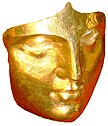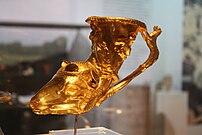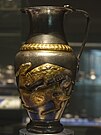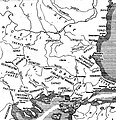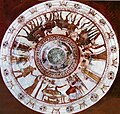Thracians
This article needs additional citations for verification. (April 2022) |

| This article is part of a series on |
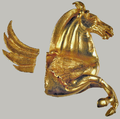 |
| Thrace |
| Geography |
|---|
| Culture |
| Tribes |
| History |
| Warfare |
| Roman Thrace |
| Mythology |
| Legacy |
The Thracians (/ˈθreɪʃənz/; Ancient Greek: Θρᾷκες, romanized: Thrāikes; Latin: Thraci) were an Indo-European speaking people who inhabited large parts of Southeast Europe in ancient history.[1][2] Thracians resided mainly in Southeast Europe in modern-day Bulgaria, Romania, North Macedonia, northern Greece and European Turkey, but also in north-western Anatolia (Asia Minor) in Turkey.
The exact origin of the Thracians is uncertain, but it is believed that Thracians like other Indo-European speaking groups in Europe descended from a mixture of Proto-Indo-Europeans and Early European Farmers.[3]
Around the 5th millennium BC, the inhabitants of the eastern region of the Balkans became organized in different groups of indigenous people that were later named by the ancient Greeks under the single ethnonym of "Thracians".[4][5][6][7]
The Thracian culture emerged during the early Bronze Age, which began about 3500 BC.[4][8][9][10] From it also developed the Getae, the Dacians and other regional groups of tribes. Historical and archaeological records indicate that the Thracian culture flourished in the 3rd and 2nd millennium BC.[4][11][12] Writing in the 6th century BC, Xenophanes described Thracians as "blue-eyed and red-haired".[13]
According to Greek and Roman historians, the Thracians were uncivilized and remained largely disunited, until the establishment of their first permanent state the Odrysian kingdom in the very beginning of 5th century BC, founded by king Teres I, exploiting the collapse of the Persian presence in Europe due to failed invasion of Greece in 480–79.[14] Teres and his son Sitalces pursued a policy of expansion, making the kingdom one of the most powerful of its time. Throughout much of its early history it remained an ally of Athens and even joined the Peloponnesian War on its side. By 400 BC the state showed first signs of fatigue, although the skilled Cotys I initiated a brief renaissance that lasted until his murder in 360 BC. In the late 4th century BC around 340 BC the Odrysian kingdom lost independence to Macedon, becoming incorporated into the empire, but it regained independence following Alexander the Great's death. A much smaller Odrysian state was revived in around 330 BC by Seuthes III, who founded a new capital named Seuthopolis.
The Thracians faced gradual conquest by the Romans from the mid 2nd century BC under whom they faced internal strife. They composed major parts of rebellions against the Romans along with the Macedonians until the Third Macedonian War. Beginning in 73 BC, Spartacus, a Thracian warrior from the Maedi tribe who was enslaved as a gladiator by the Romans, led a revolt that posed a significant challenge to Roman authority, prompting a series of military campaigns against it. The aftermath of the rebellion saw the crucifixion of 6,000 surviving rebels along the Appian Way. The Odrysian kingdom was attacked by the Roman Republic in the late 1st century BC, when the Odrysian heartlands eventually became known as the Sapaean kingdom, a client state of the Roman Republic, which was finally abolished and converted into a Roman province of Thracia in 45-46 AD.

Thracians were described as "warlike" and "barbarians" by the Greeks and Romans since they were neither Romans nor Greeks but in spite of that they were favored as excellent mercenaries. While the Thracians were perceived as unsophisticated by the Romans and Greeks, their culture was reportedly noted for its sophisticated poetry and music.[15] Since the 19th century-early 20th century, Bulgaria and Romania have used archaeology to learn more about Thracian culture and way of life.
Thracians followed a polytheistic religion with monotheistic elements. One of their customs was tattooing, common among both men and women.[16] The Thracians culturally interacted with the peoples surrounding them – Greeks, Persians, Scythians and Celts[17][18] Thracians spoke the now extinct Thracian language and shared a common culture.[1] The last reported use of a Thracian language was by monks in the 6th century AD. The scientific study of the Thracians is known as Thracology.
Etymology
[edit]The first historical record of the ethnonym Thracian is found in the Iliad, where the Thracians are described as allies of the Trojans in the Trojan War against the Ancient Greeks.[19] The ethnonym Thracian comes from Ancient Greek Θρᾷξ (Thrāix; plural Θρᾷκες, Thrāikes) or Θρᾴκιος (Thrāikios; Ionic: Θρηίκιος, Thrēikios), and the toponym Thrace comes from Θρᾴκη (Thrāikē; Ionic: Θρῄκη, Thrēikē).[20] These forms are all exonyms as applied by the Greeks.[21]
Mythological foundation
[edit]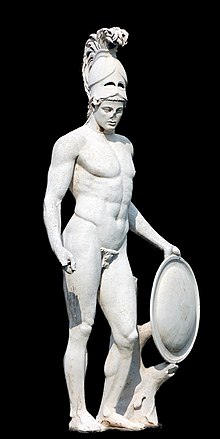
In Greek mythology, Thrax (his name simply the quintessential Thracian) was regarded as one of the reputed sons of the god Ares.[22] In the Alcestis, Euripides mentions that one of the names of Ares himself was "Thrax". Since Ares was regarded as the patron of Thrace his golden or gilded shield was kept in his temple at Bistonia in Thrace.[23]
Origins
[edit]The origins of the Thracians remain obscure due to the absence of written historical records before they made contact with the Greeks.[24] Evidence of proto-Thracians in the prehistoric period depends on artifacts of material culture. Leo Klejn identifies proto-Thracians with the multi-cordoned ware culture that was pushed away from Ukraine by the advancing timber grave culture or Srubnaya. It is generally proposed that a Thracian people developed from a mixture of indigenous peoples and Indo-Europeans from the time of Proto-Indo-European expansion in the Early Bronze Age[25] when the latter, around 1500 BC, mixed with indigenous peoples.[26] According to one theory, their ancestors migrated in three waves from the northeast: the first in the Late Neolithic, forcing out the Pelasgians and Achaeans, the second in the Early Bronze Age, and the third around 1200 BC. They reached the Aegean islands, ending the Mycenaean civilization. They did not speak the same language.[24] The lack of written archeological records left by Thracians suggests that the diverse topography did not make it possible for a single language to form.[24]
Ancient Greek and Roman historians agreed that the ancient Thracians were superior fighters; only their constant political fragmentation prevented them from overrunning the lands around the northeastern Mediterranean.[27] Although these historians characterized the Thracians as "primitive" partly because they lived in simple, open villages, the Thracians in fact had a fairly advanced culture that was especially noted for its poetry and music. Their soldiers were valued as mercenaries, particularly by the Macedonians and Romans.[27]
Identity and distribution
[edit]Thracians inhabited parts of the ancient provinces of Thrace, Moesia, Macedonia, Beotia, Attica, Dacia, Scythia Minor, Sarmatia, Bithynia, Mysia, Pannonia, and other regions of the Balkans and Anatolia. This area extended over most of the Balkans region, and the Getae north of the Danube as far as beyond the Bug and including Pannonia in the west.[28]
According to Ethnica, a geographical dictionary by Stephanus of Byzantium, Thrace—the land of the Thracians—was known as Perki (Περκη) and Aria (Αρια) before being named Thrace by the Greeks,[29][30] presumably due to the affiliation of the Thracians with the god Ares[31] and Perki is the reflexive name of the god Ares as *Perkʷūnos.[32]

Thucydides[31] mentions about a period in the past, from his point of view, when Thracians had inhabited the region of Phocis, also known as the location of Delphi. He dates it to the lifetime of Tereus – mythological Thracian king and son of the god Ares.
Due to the lack of historical records that predate Classical Greece it's presumed that the Thracians did not manage to form a lasting political organization until the Odrysian state was founded in the 5th century BC. In the 1st century BC, during King Burebista's rule, emerged the powerful state of Dacia.
Currently, there are about 200 identified Thracian tribes.[33] The most prominent tribe, the Moesi achieved significant importance during Roman rule.[34] What's notable about the Moesians is that they practiced vegetarianism, feeding themselves on honey, milk, and cheese.[35]
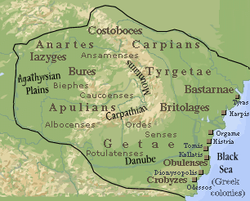
Greek and Roman descriptions
[edit]Thracians were regarded by ancient Greeks and Romans as warlike, ferocious, bloodthirsty, and barbarian.[36][37][38] Plato in his Republic groups them with the Scythians,[39] calling them extravagant and high spirited; and in his Laws portrays them as a warlike nation, grouping them with Celts, Persians, Scythians, Iberians and Carthaginians.[40] Polybius wrote of Cotys's sober and gentle character being unlike that of most Thracians.[41] Tacitus in his Annals writes of them being wild, savage and impatient, disobedient even to their own kings.[42] The Thracians have been said to have "tattooed their bodies, obtained their wives by purchase, and often sold their children".[38] The French historian Victor Duruy further notes that they "considered husbandry unworthy of a warrior, and knew no source of gain but war and theft".[38] He also states that they practiced human sacrifice,[38] which has been confirmed by archaeological evidence.[43]
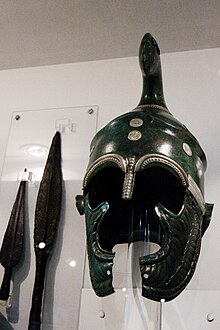
Polyaenus and Strabo write how the Thracians broke their pacts of truce with trickery.[44][45] Polyaneus testifies that the Thracians struck their weapons against each other before battle, "in the Thracian manner".[46] Diegylis, leader of the Caeni, was considered one of the most bloodthirsty chieftains by Diodorus Siculus. An Athenian club for lawless youths was named after the thracian tribe Triballi[47] which might be the origin of the word tribe.
According to ancient Roman sources, the Dii[48] were responsible for the worst[49] atrocities in the Peloponnesian War, killing every living thing, including children and dogs in Tanagra and Mycalessos.[48] The Dii would impale Roman heads on their spears and rhomphaias such as in the Kallinikos skirmish at 171 BC.[49] Strabo treated the Thracians as barbarians, and held that they spoke the same language as the Getae.[50] Some Roman authors noted that even after the introduction of Latin they still kept their "barbarous" ways.[38] Herodotus writes that "the thracians sell their children and let their maidens commerce with whatever men they please".[51]
The accuracy and impartiality of these descriptions have been called into question in modern times, given the seeming embellishments in Herodotus's histories, for one.[52][53][54] Archaeologists have attempted to piece together a fuller understanding of Thracian culture through the study of their artifacts.[55]
Physical appearance
[edit]

Several Thracian graves or tombstones have the name Rufus inscribed on them, meaning "redhead" – a common name given to people with red hair[56] which led to associating the name with slaves when the Romans enslaved this particular group.[57] Ancient Greek artwork often depicts Thracians as redheads.[58] Rhesus of Thrace, a mythological Thracian king, was so named because of his red hair and is depicted on Greek pottery as having red hair and a red beard.[58] Ancient Greek writers also described the Thracians as red-haired. A fragment by the Greek poet Xenophanes describes the Thracians as blue-eyed and red haired:
...Men make gods in their own image; those of the Ethiopians are black and snub-nosed, those of the Thracians have blue eyes and red hair.[59]
Bacchylides described Theseus as wearing a hat with red hair, which classicists believe was Thracian in origin.[60] Other ancient writers who described the hair of the Thracians as red include Hecataeus of Miletus,[61] Galen,[62] Clement of Alexandria,[63] and Julius Firmicus Maternus.[64]
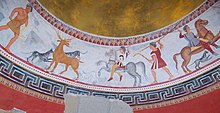
Nevertheless, academic studies[citation needed] have concluded that people often had different physical features from those described by primary sources. Ancient authors described as red-haired several groups of people. They claimed that all Slavs had red hair, and likewise described the Scythians as red haired. According to Beth Cohen, Thracians had "the same dark hair and the same facial features as the Ancient Greeks."[65] However, Aris N. Poulianos states that Thracians, like modern Bulgarians, belonged mainly to the Aegean anthropological type.[66]
History
[edit]Homeric period
[edit]The earliest known mention of Thracians is in the second song of Homer's Iliad, where the population inhabiting the Thracian Chersonesus is said to have participated in the Trojan War, which is believed to have taken place around 12th century BC. This population is referred to with the following name:
"...And Hippothous led the tribes of the Pelasgi, that rage with the spear, even them that dwelt in deep-soiled Larisa; these were led by Hippothous and Pylaeus, scion of Ares, sons twain of Pelasgian Lethus, son of Teutamus. But the Thracians Acamas led and Peirous, the warrior, even all them that the strong stream of the Hellespont encloseth."[67][68][69]
Archaic period
[edit]The first Greek colonies along the Thracian coasts (first the Aegean, then the Marmara and Black Seas) were founded in the 8th century BC.[70] Thracians and Greeks lived side-by-side. Ancient sources record a Thracian presence on the Aegean islands and in Hellas (the broader "land of the Hellenes").[71]
At some point in the 7th century BC, a portion of the Thracian Treres tribe migrated across the Thracian Bosporus and invaded Anatolia.[72] In 637 BC, the Treres under their king Kobos (Ancient Greek: Κώβος Kṓbos; Latin: Cobus), in alliance with the Cimmerians and the Lycians, attacked the kingdom of Lydia during the seventh year of the reign of the Lydian king Ardys.[73] They defeated the Lydians and captured the capital city of Lydia, Sardis, except for its citadel, and Ardys might have been killed in this attack.[74] Ardys's son and successor, Sadyattes, might possibly also have been killed in another Cimmerian attack on Lydia.[74] Soon after 635 BC, with Assyrian approval[75] the Scythians under Madyes entered Anatolia. In alliance with Sadyattes's son, the Lydian king Alyattes,[76][77] Madyes expelled the Treres from Asia Minor and defeated the Cimmerians so that they no longer constituted a threat again, following which the Scythians extended their domination to Central Anatolia[78] until they were themselves expelled by the Medes from Western Asia in the 600s BC.[73]
Achaemenid Thrace
[edit]
In the 6th century BC the Persian Achaemenid Empire conquered Thrace, starting in 513 BC, when the Achaemenid king Darius I amassed an army and marched from Achaemenid-ruled Anatolia into Thrace, and from there he crossed the Arteskos river and then proceeded through the valley-route of the Hebros river. This was an act of conquest by Darius I, who sought to create a new satrapy in the Balkans, and had during his march sent emissaries to the Thracians found on the path of his army as well as to the many other Thracian tribes over a wide area. All these peoples of Thrace, including the Odrysae, submitted to the Achaemenid king until his army reached the territory of Thracian tribe of the Getae who lived just south of the Danube river and who in vain attempted to resist the Achaemenid conquest. After the resistance of the Getae was defeated and they were forced to provide the Achaemenid army with soldiers, all the Thracian tribes between the Aegean Sea and the Danube river had been subjected by the Achaemenid Empire. Once Darius had reached the Danube, he crossed the river and campaigned against the Scythians, after which he returned to Anatolia through Thrace and left a large army in Europe under the command of his general Megabazus.[79]
Following Darius I's orders to create a new satrapy for the Achaemenid Empire in the Balkans, Megabazus forced the Greek cities who had refused to submit to the Achaemenid Empire, starting with Perinthus, after which led military campaigns throughout Thrace to impose Achaemenid rule over every city and tribe in the area. With the help of Thracian guides, Megabazus was able to conquer Paeonia up to but not including the area of Lake Prasias, and he gave the lands of the Paeonians inhabiting these regions up to the Lake Prasias to Thracians loyal to the Achaemenid Empire. The last endeavours of Megabazus included his the conquest of the area between the Strymon and Axius rivers, and at the end of his campaign, the king of Macedonia, Amyntas I, accepted to become a vassal of the Achaemenid Empire. Within the satrapy itself, the Achaemenid king Darius granted to the tyrant Histiaeus of Miletus the district of Myrcinus on the Strymon's east bank until Megabazus persuaded him to recall Histiaeus after he returned to Asia Minor, after which the Thracian tribe of the Edoni retook control of Myrcinus.[79] The new satrapy, once created, was named Skudra (𐎿𐎤𐎢𐎭𐎼), derived from Scythian the name Skuδa, which was the self-designation of the Scythians who inhabited the northern parts of the satrapy.[80] Once Megabazus had returned to Asia Minor, he was succeeded in Skudra by a governor whose name is unknown, and Darius appointed the general Otanes to oversee the administrative division of the Hellespont, which extended on both sides of the sea and included the Bosporus, the Propontis, and the Hellespont proper and its approaches. Otanes then proceeded to capture Byzantium, Chalcedon, Antandrus, Lamponeia, Imbros, and Lemnos for the Achaemenid Empire.[79]

The area included within the satrapy of Skudra included both the Aegean coast of Thrace, as well as its Pontic coast till the Danube. In the interior, the Western border of the satrapy consisted of the Axius river and the Belasica-Pirin-Rila mountain ranges till the site of modern-day Kostenets. The importance of this satrapy rested in that it contained the Hebros river, where a route in the river valley connected the permanent Persian settlement of Doriscus with the Aegean coast, as well as with the port-cities of Apollonia, Mesembria and Odessos on the Black Sea, and with the central Thracian plain, which gave this region an important strategic value. Persian sources describe the province as being populated by three groups: the Saka Paradraya ("Saka beyond the sea", the Persian term for all Scythian peoples to the north of the Caspian and Black Seas [81][82]); the Skudra themselves (most likely the Thracian tribes), and Yauna Takabara. The latter term, which translates as "Ionians with shield-like hats", is believed to refer to Macedonians. The three ethnicities (Saka, Macedonian, Thracian) enrolled in the Achaemenid army, as shown in the Imperial tomb reliefs of Naqsh-e Rostam, and participated in the Second Persian invasion of Greece on the Achaemenid side.[83]
When Achaemenid control over its European possessions collapsed once the Ionian Revolt started, the Thracians did not help the Greek rebels, and they instead saw Achaemenid rule as more favourable because the latter had treated the Thracians with favour and even given them more land, and also because they realised that Achaemenid rule was a bulwark against Greek expansion and Scythian attacks. During the revolt, Aristagoras of Miletus captured Myrcinus from the Edones and died trying to attack another Thracian city.[79]
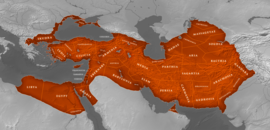
Once the Ionian Revolt had been fully quelled, the Achaemenid general Mardonius crossed the Hellespont with a large fleet and army, re-subjugated Thrace without any effort and made Macedonia full part of the satrapy of Skudra. Mardonius was however attacked at night by the Bryges in the area of Lake Doiran and modern-day Valandovo, but he was able to defeat and submit them as well. Herodotus's list of tribes who provided the Achaemenid army with soldiers included Thracians from both the coast and from the central Thracian plain, attesting that Mardonius's campaign had reconquered all the Thracian areas which were under Achaemenid rule before the Ionian Revolt.[79]
When the Greeks defeated a second invasion attempt by the Persian Empire in 479 BC, they started attacking the satrapy of Skudra, which was resisted by both the Thracians and the Persian forces. The Thracians kept on sending supplies to the governor of Eion when the Greeks besieged it. When the city fell to the Greeks in 475 BC, Cimon gave its land to Athens for colonisation. Although Athens was now in control of the Aegean Sea and the Hellespont following the defeat of the Persian invasion, the Persians were still able to control the southern coast of Thrace from a base in central Thrace and with the support of the Thracians. Thanks to the Thracians co-operating with the Persians by sending supplies and military reinforcements down the Hebrus river route, Achaemenid authority in central Thrace lasted until around 465 BC, and the governor Mascames managed to resist many Greek attacks in Doriscus until then.[79]
Around this time, Teres I, the king of the Odrysae tribe, in whose territory the Hebrus flowed, was starting to organise the rise of his kingdom into a powerful state. With the end of Achaemenid power in the Balkans, the Thracian Odrysian kingdom, the Kingdom of Macedonia, and the Athenian thalassocracy filled the ensuing power vacuum and formed their own spheres of influence in the area.[79]
Odrysian Kingdom
[edit]
The Odrysian Kingdom was a state union of over 40 Thracian tribes[84] and 22 kingdoms[85] that existed between the 5th century BC and the 1st century AD. It consisted mainly of present-day Bulgaria, spreading to parts of Southeastern Romania (Northern Dobruja), parts of Northern Greece and parts of modern-day European Turkey.[citation needed]
By the 5th century BC, the Thracian population was large enough that Herodotus called them the second-most numerous people in the part of the world known by him (after the Indians), and potentially the most powerful, if not for their lack of unity.[86] The Thracians in classical times were broken up into a large number of groups and tribes, though a number of powerful Thracian states were organized, the most important being the Odrysian kingdom of Thrace, and also the short lived Dacian kingdom of Burebista. The peltast is a type of soldier of this period that originated in Thrace.[87]
At this time, a subculture of celibate ascetics called the "ctistae" lived in Thrace, where they served as philosophers, priests and prophets. They were held in a place of honor by the Thracians, with their lives being dedicated to the gods.[88]
Macedonian Thrace
[edit]During this period, contacts between the Thracians and Classical Greece intensified.[citation needed]
After the Persians withdrew from Europe and before the expansion of the Kingdom of Macedon, Thrace was divided into three regions (east, central, and west). A notable ruler of the East Thracians was Cersobleptes, who attempted to expand his authority over many of the Thracian tribes. He was eventually defeated by the Macedonians.[citation needed]
The Thracians were typically not city-builders[89][90] and their only polis was Seuthopolis.[91][92]
The conquest of the southern part of Thrace by Philip II of Macedon in the 4th century BC made the Odrysian kingdom extinct for several years. After the kingdom was reestablished, it was a vassal state of Macedon for several decades under generals such as Lysimachus of the Diadochi.[citation needed]
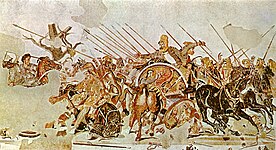
In 336 BC, Alexander the Great began recruiting thracian cavalry and javelin men in his army, who accompnied him on his continuous conquest to expand the borders of the Macedonian Empire.[93] The strength of the thracian cavalry quickly grew from 150 men, to 1000 men by the time Alexander advanced into Egypt, and numbered 1600 when he reached the persian city of Susa. The thracian infantry was under the command of the Odrysian prince Sitalces II who led them in the siege of Telmissus and in the battles of Issus and Gaugamela.[93]
In 279 BC, Celtic Gauls advanced into Macedonia, southern Greece and Thrace. They were soon forced out of Macedonia and southern Greece, but they remained in Thrace until the end of the 3rd century BC. From Thrace, three Celtic tribes advanced into Anatolia and established the kingdom of Galatia.[citation needed]
In western parts of Moesia, Celts (Scordisci) and Thracians lived alongside each other, as evident from the archaeological findings of pits and treasures, spanning from the 3rd century BC to the 1st century BC.[94]
Greek raids to enslave Thracians
[edit]Slave raids were a specific form of banditry that was the primary method employed by the ancient Greeks for gathering slaves. In regions such as Thrace and the eastern Aegean, natives, or "barbarians", captured in these raids were the main source of slaves, rather than prisoners of war. As described by Xenophon, and Menander in Aspis, after the slaves were captured in raids, their actual enslavement took place when they were resold through slave-dealers to Athenians and other slaveowners throughout Greece. The fragmentary list of slaves confiscated from the property of the mutilators of the Hermai mentions 32 slaves whose origins have been ascertained: 13 came from Thrace, 7 from Caria, and the others came from Cappadocia, Scythia, Phrygia, Lydia, Syria, Ilyria, Macedon, and Peloponnese. The names given to slaves in the comedies often had a geographical link, thus Thratta, used by Aristophanes in The Wasps, The Acharnians, and Peace, simply meant a Thracian woman. The ethnicity of a slave was a significant criterion for major purchasers: Ancient practice was to avoid a concentration of too many slaves of the same ethnic origin in the same place, in order to limit the risk of revolt.
Roman Thrace
[edit]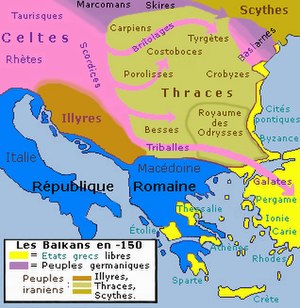
During the Macedonian Wars, conflict between Rome and Thrace was unavoidable. The rulers of Macedonia were weak, and Thracian tribal authority resurged. But after the Battle of Pydna in 168 BC, Roman authority over Macedonia seemed inevitable, and the governance of Thrace passed to Rome.[citation needed]
Initially, Thracians and Macedonians revolted against Roman rule. For example, the revolt of Andriscus, in 149 BC, drew the bulk of its support from Thrace. Incursions by local tribes into Macedonia continued for many years, though a few tribes, such as the Deneletae and the Bessi, willingly allied with Rome.[citation needed]
After the Third Macedonian War, Thrace acknowledged Roman authority. The client state of Thracia comprised several tribes.[citation needed]
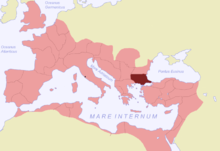
The next century and a half saw the slow development of Thracia into a permanent Roman client state. The Sapaei tribe came to the forefront initially under the rule of Rhascuporis. He was known to have granted assistance to both Pompey and Caesar, and later supported the Republican armies against Mark Antony and Octavian in the final days of the Republic.[citation needed]
The heirs of Rhascuporis became as deeply enmeshed in political scandal and murder as were their Roman masters. A series of royal assassinations altered the ruling landscape for several years in the early Roman imperial period. Various factions took control with the support of the Roman Emperor. The turmoil would eventually end with one final assassination.[citation needed]
After Rhoemetalces III of the Thracian Kingdom of Sapes was murdered in AD 46 by his wife, Thracia was incorporated as an official Roman province to be governed by Procurators, and later Praetorian prefects. The central governing authority of Rome was in Perinthus, but regions within the province were under the command of military subordinates to the governor. The lack of large urban centers made Thracia a difficult place to manage, but eventually the province flourished under Roman rule. However, Romanization was not attempted in the province of Thracia. The Balkan Sprachbund does not support Hellenization.[citation needed]
Roman authority in Thracia rested mainly with the legions stationed in Moesia. The rural nature of Thracia's populations, and distance from Roman authority, certainly inspired local troops to support Moesia's legions. Over the next few centuries, the province was periodically and increasingly attacked by migrating Germanic tribes. The reign of Justinian saw the construction of over 100 legionary fortresses to supplement the defense.[citation needed]
Aftermath
[edit]
The ancient languages of these people and their cultural influence were highly reduced due to the repeated invasions of the Balkans by Romans, Celts, Huns, Goths, Scythians, Sarmatians and Slavs, accompanied by, hellenization, romanization and later slavicisation. However, the Thracians as a group only disappeared in the Early Middle Ages.[95] Towards the end of the 4th century, Nicetas the Bishop of Remesiana brought the gospel to "those mountain wolves", the Bessi.[96] Reportedly his mission was successful, and the worship of Dionysus and other Thracian gods was eventually replaced by Christianity.
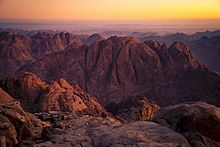
In 570, Antoninus Placentius said that in the valleys of Mount Sinai there was a monastery in which the monks spoke Greek, Latin, Syriac, Egyptian and Bessian. The origin of the monasteries is explained in a medieval hagiography written by Simeon Metaphrastes, in Vita Sancti Theodosii Coenobiarchae in which he wrote that Theodosius the Cenobiarch founded on the shore of the Dead Sea a monastery with four churches, in each being spoken a different language, among which Bessian was found. The place where the monasteries were founded was called "Cutila", which may be a Thracian name.[97]
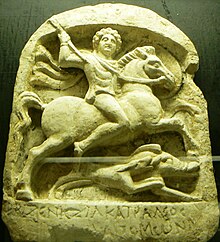
The further fate of the Thracians is a matter of dispute. German historian Gottfried Schramm speculated that the Albanians derived from the Christianized Thracian tribe Bessi, after their remnants were allegedly pushed by Slavs and Bulgars during the 9th century westwards into modern day Albania.[96] However, archaeologically, there is absolutely no evidence of a 9th-century migration of any population, such as the Bessi, from western Bulgaria to Albania.[98] Also from a linguistic point of view it emerges that the Thracian-Bessian hypothesis of the origin of Albanian should be rejected, since only very little comparative linguistic material is available (the Thracian is attested only marginally, while the Bessian is completely unknown), but at the same time the individual phonetic history of Albanian and Thracian clearly indicates a very different sound development that cannot be considered as the result of one language. Furthermore, the Christian vocabulary of Albanian is mainly Latin, which speaks against the construct of a "Thracian-Bessian church language".[99] Most probably the Thracians were assimilated into the Roman and later in the Byzantine society and became part of the ancestral groups of the modern Southeastern Europeans.[100]
Oddly the last mention of Thracians, in the 6th century, coincides with the first mention of Slavs, when the Slavic tribes inhabited large territories of Central and Eastern Europe.[101] After the 6th century Thracians that weren't already assimilated in the Byzantine Empire, were incorporated in the slavic speaking Bulgarian Empire.[102]
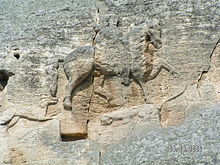
Bulgarian Thrace
Slavic tribes had mingled with the Thracian population, prior to the formation of the Bulgarian state.[102] Under the leadership of Asparuh, in 680 AD the Thracians, Bulgars and Slavs readily united to establish the First Bulgarian Empire.[103][104] These three ethnic groups mingled to produce the Bulgarian people.[105] The Byzantine Empire, retained control over Thrace until the 7th century when the northern half of the entire region was claimed by the First Bulgarian Empire and the remainder was reorganized in the Thracian theme.
Legacy
[edit]A recent Bulgarian study on the heritage of Thracian mounds in Bulgaria claims historical, cultural and ethnic links between Thracians and Bulgarians.[106][105] Genetic studies on modern Bulgarians show that approximately 55% of Bulgarian autosomal genetic legacy is of Paleo-Balkan and Mediterranean origin which can be attributed to Thracians and other indigenous Balkan populations predating Slavs and Bulgars.[107][108][109][110]
Greek Thrace
Turkish Thrace
Culture
[edit]
Language
[edit]The records of Thracian writing are very scarce. There are only four inscriptions that have been discovered. One of them is a gold ring unearthed in the village of Ezerovo, Bulgaria. The thracian inscription is written using the Greek script and consists of 8 lines. Attempts to decipher the inscription have proven inconclusive.[111]
Religion
[edit]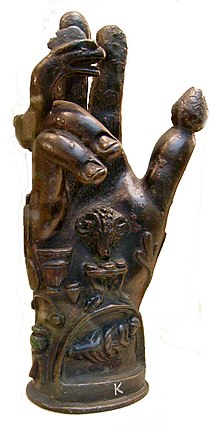
One notable cult that existed in Thrace, Moesia, Phrygia and the lands of the Dacians and the Getae (Scythia Minor, now Dobrudja) was that of the "Thracian horseman", also known as Sabazios or "Thracian Heros" known by a Thracian name as Heros Karabazmos, a god of the underworld, who was usually depicted on funeral statues as a horseman slaying a beast with a spear.[112][113][114] Getae and Dacians potentially had a monotheistic religion based on the god Zalmoxis, though this is heavily debated in the anthropological community.[115] The supreme Balkan thunder god Perkon was part of the Thracian pantheon, although cults of Orpheus and Zalmoxis likely overshadowed his.[citation needed]
The Thracians are considered the first to worship the god of wine called Dionysus in Greek or Zagreus in Thracian.[116] Later this cult reached Ancient Greece.[117][118] Some consider Thrace as the motherland of wine culture.[119] The works of Homer, Herodotus and other historians of Ancient Greece also refer to the ancient Thracians' love for winemaking and consumption, also related to religion[120] as early as 6000 years ago.[121]
Marriage
[edit]The male Thracians were polygamous. Menander puts it: "All Thracians, especially us and the Getae, are not much abstaining, because no one takes less than ten, eleven, twelve wives, some even more. If one dies and has only four or five wives he is called ill-fated, unhappy and unmarried."[122] According to Herodotus virginity among women was not valued, and unmarried Thracian women could have sex with any man they wished to.[122] There were men perceived as holy Thracians, who lived without women and were called "ktisti".[122] In myth, Orpheus rebuked the sexual advances of the Bistones women after the death of Eurydice, and was killed for not engaging in the activities promoted by the followers of Dionysus.
Warfare
[edit]
The Thracians were a warrior people, known as both horsemen and lightly armed skirmishers with javelins.[123] Thracian peltasts had a notable influence in Ancient Greece.[124]
The history of Thracian warfare spans from c. 10th century BC up to the 1st century AD in the region defined by Ancient Greek and Latin historians as Thrace. It concerns the armed conflicts of the Thracian tribes and their kingdoms in the Balkans and in the Dacian territories. Emperor Traianus, also known as Trajan, conquered Dacia after two wars in the 2nd century AD. The wars ended with the occupation of the fortress of Sarmisegetusa and the death of the king Decebalus. Besides conflicts between Thracians and neighboring nations and tribes, numerous wars were recorded among Thracian tribes too.[citation needed]
Genetics
[edit]A genetic study published in Scientific Reports in 2019 examined the mtDNA of 25 Thracian remains in Bulgaria from the 3rd and 2nd millennia BC. They were found to harbor a mixture of ancestry from Western Steppe Herders (WSHs) and Early European Farmers (EEFs), supporting the idea that Southeast Europe was the link between Eastern Europe and the Mediterranean.[3]
A Bulgarian study from 2013 claims genetic similarity between Thracians (8-6 century BC), medieval Bulgarians (8–10 century AD), and modern Bulgarians, highlighting highest resemblance between them and Romanians, Northern Italians and Northern Greeks.[125]
Examinations of Iron Age and ancient Thracian remains in Bulgaria were found to mainly carry the Y-DNA haplogroup E-V13.[126] The tested samples were further specifically listed as: E-BY3880 x 3, E-L618 x 2, E-M78 x 2, R-Z93, E-CTS1273, E-BY14160.[126] Six of the samples were predicted for having brown eyes while two for having blue eyes, while majority of the samples were predicted for an intermediate skin color and hair color prediction ranged from majority brown on detailed, to light and dark.[127]
Notable people
[edit]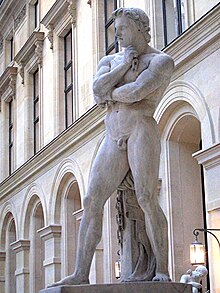
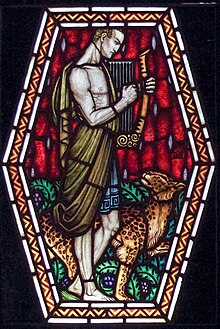
This is a list of historically important personalities being entirely or partly of Thracian and Dacian ancestry:
- Orpheus, mythological figure considered chief among poets and musicians; king of the Thracian tribe of Cicones
- Rhesus of Thrace, mythical king of Thrace in The Iliad who fought on the side of Trojans
- Eumolpus, legendary king of Thrace described as having come to Attica either as a bard, a warrior, or a priest of Demeter and Dionysus
- Tereus, mythological Thracian king,[128][129] the son of Ares and the naiad Bistonis
- Spartacus, Thracian gladiator who led a large slave uprising in Southern Italy in 73–71 BC and defeated several Roman legions in what is known as the Third Servile War
- Amadocus, Thracian King, the Amadok Point was named after him
- Teres I, Thracian King who united many tribes of Thrace under the banner of the Odrysian state
- Seuthes I
- Seuthes II
- Seuthes III
- Cotys I
- Sitalces, King of the Odrysian state; an ally of the Athenians during the Peloponnesian War
- Burebista, King of Dacia
- Decebalus, King of Dacia
- Maximinus Thrax, Roman Emperor from 235 to 238.[130]
- Aureolus, Roman military commander
- Galerius, Roman Emperor from 305 to 311; born to a Thracian father and Dacian mother
- Constantine the Great, Roman Emperor from 306 to 337; born to Thracian father[131][132] from Naissus and Thracian (Bithynian) mother in Naissus
- Licinius, Roman Emperor from 308 to 324
- Maximinus Daia or Maximinus Daza, Roman Emperor from 308 to 313
- Justin I, Eastern Roman Emperor and founder of the Justinian dynasty
- Justinian the Great, Eastern Roman Emperor; either Illyrian or Thracian, born in Dardania
- Belisarius, Eastern Roman general of reputed Illyrian, Greek or Thracian origin
- Marcian, Eastern Roman Emperor from 450 to 457; either Illyrian or Thracian
- Leo I the Thracian, Eastern Roman Emperor from 457 to 474
- Bouzes or Buzes, Eastern Roman general active during the reign of Justinian the Great (r. 527–565)
- Coutzes or Cutzes, general of the Byzantine Empire during the reign of Emperor Justinian I
Thracology
[edit]Archaeology
[edit]The branch of science that studies the ancient Thracians and Thrace is called Thracology. Archaeological research on the Thracian culture started in the 20th century, especially after World War II, mainly in southern Bulgaria. As a result of intensive excavations in the 1960s and 1970s a number of Thracian tombs and sanctuaries were discovered. Most significant among them are: the Getic burial complex and the Tomb of Sveshtari, the Valley of the Thracian Rulers and the Tomb of Kazanlak, Tatul, Seuthopolis, Perperikon, Tomb of Aleksandrovo in Bulgaria, Sarmizegetusa in Romania and others.[citation needed] Also a large number of elaborately crafted gold and silver treasure sets from the 5th and 4th century BC were unearthed. In the following decades, those were exhibited in museums around the world, thus calling attention to ancient Thracian culture. Since the year 2000, Bulgarian archaeologist Georgi Kitov has made discoveries in Central Bulgaria, in an area now known as "The Valley of the Thracian Kings". The residence of the Odrysian kings was found in Starosel in the Sredna Gora mountains.[133][134] A 1922 Bulgarian study claimed that there were at least 6,269 necropolises[clarification needed] in Bulgaria.[135]
Multidisciplinary Studies
[edit]The dominant stance of history and archaeology as the two main disciplines dealing with the Thracians as a subject of research has been succeeded by a clear shift towards new multidisciplinary and more inclusive scientific perspectives. An example of this new trend was the large-scale multidisciplinary project "Thracians – Genesis and Development of the Ethnos, Cultural Identities, Civilization Relations and Heritage of the Antiquity", launched in 2016 in Bulgaria. The project was the first comprehensive study of the Thracian heritage including 72 scholars from 18 institutes of the Bulgarian Academy of Science, as well as researchers from Canada, Italy, Germany, Japan and Switzerland. The project studied 13 scientific themes among which: formation of the Thracian ethnos, outlining of its ethno-cultural territory, continuity of the gene pool and related DNA studies, architectural, botanical, microbiological, astronomical, acoustic and linguistic aspects, mining and ceramics technologies, food and drink customs, that resulted in an extensively illustrated book including 33 scientific articles.[136]
Gallery
[edit]-
Thracian tribes and heroes
-
Map of the territory of Philip II of Macedon
-
Kingdom of Lysimachus and the Diadochi
-
Map of the Diocese of Thrace (Dioecesis Thraciae) c. 400 AD
-
Golden Dacian helmet of Cotofenesti, in Romania
-
Gold coins that have been minted by the Dacians, with the legend ΚΟΣΩΝ
-
A gold Thracian treasure from Panagyurishte, Bulgaria
-
Thracian tomb Shushmanets, built in 4th century BC
-
The interior of the Sveshtari tomb
-
Interior of Tomb of Seuthes III
-
Bronze head of Seuthes III
-
Thracian Cavalry
-
Thracian Horseman Relief
-
Coin of Seuthes III
-
The Thracian Horseman on the modern Bulgarian currency
See also
[edit]References
[edit]- ^ a b Webber 2001, p. 3. "The Thracians were an Indo-European people who occupied the area between northern Greece, Romania, and north-western Turkey. They shared the same language and culture... There may have been as many as a million Thracians, divided among up to 40 tribes."
- ^ Modi et al. 2019. "One of the best documented Indo-European civilizations that inhabited Romania, Bulgaria is the Thracians..."
- ^ a b Modi et al. 2019.
- ^ a b c Nature (2019) Ancient human mitochondrial genomes from Bronze Age Bulgaria: new insights into the genetic history of Thracians
- ^ Popov, D. The Greek intellectuals and the Thracian world. Iztok - Zapad 2, 13–203 (2013).
- ^ Fol, A. The Thracian orfeism. Sofia, 145–244 (1986).
- ^ Fol, A. The History of Bulgarian lands in antiquity. Tangra TanNakRa, 11–300 (2008).
- ^ Chichikova, M. The Thracian city - Terra Antiqua Balcanica. GSU IF C, 85–93 (1985).
- ^ Danov, H. G. Thracian a source of knowledge. Veliko Tarnovo, 50–58 (1998).
- ^ Raicheva, L. Thracians and Orpheism. IK Ogledalo, 5–59 (2014).
- ^ Fol, A., Georgiev, V. & Danov, H. The History of Bulgaria. Primarily - communal and slavery. Thracians. BAS, Sofia 1, 110–274 (1979).
- ^ Mihailov, G. The Thracians. New Bulgarian University 2, 1–491 (2015).
- ^ Fragment B16 within "the well-known fragments" B14-B16, "Xenophanes", Stanford Encyclopedia of Philosophy (Accessed: February 20, 2023).
- ^ Rehm, Ellen (2010). "The Impact of the Achaemenids on Thrace: A Historical Review". In Nieling, Jens; Rehm, Ellen (eds.). Achaemenid Impact in the Black Sea: Communication of Powers. Black Sea Studies. Vol. 11. Aarhus University Press. p. 143. ISBN 978-8779344310.
In 470/469 BC, the strategist Kimon, mentioned above, defeated the Persian fleet at the mouth of the Eurymedon river. Subsequently, it seems that the royal house of the Odrysians in Thrace gained power and in about 465/464 BC emerged from the Persian shadow. The Odrysians became aware of the power vacuum resulting from the withdrawal of the Persians and claimed back supremacy over the region inhabited by several tribes. From this period onwards an indigenous ruling dynasty is comprehensible.
- ^ "Thrace". Britannica. Archived from the original on 18 April 2021. Retrieved 18 April 2021.
- ^ Vlassopoulos, Kostas (2013). Greeks and Barbarians. Cambridge University Press. pp. 124–125. ISBN 978-1-107-24426-9.
- ^ Shchukin, M. B. (1989). Rome and the Barbarians in Central and Eastern Europe: 1st Century B.C.-1st Century A.D. B.A.R. p. 79. ISBN 978-0-86054-690-0.
- ^ Hind, J. G. F. "Archaeology of the Greeks and Barbarian Peoples around the Black Sea (1982-1992)." Archaeological Reports, no. 39, 1992, pp. 82–112. JSTOR
- ^ Boardman, John (1970). The Cambridge Ancient History, Volume 3, Part 1. Cambridge University Press. p. 836. ISBN 0-521-85073-8.
- ^ Navicula Bacchi – Θρηικίη (Accessed: October 13, 2008).
- ^ Garašanin 1982, p. 597. "We have no way of knowing what the Thracians called themselves and if indeed they had a common name... Thus the name of Thracians and that of their country were given by the Greeks to a group of Hellenic tribes occupying the territory...".
- ^ Lemprière and Wright,[full citation needed] p. 358. "Mars was father of Cupid, Anteros, and Harmonia, by the goddess Venus. He had Ascalaphus and Ialmenus by Astyoche; Alcippe by Agraulos; Molus, Pylus, Euenus, and oThestius, by Demonice the daughter of Agenor. Besides these, he was the reputed father of Romulus, Oenomaus, Bythis, Thrax, Diomedes of Thrace, &c."
- ^ Euripides, Alcestis p. 95. "[Line] 58. 'Thrace's golden shield' – One of the names of Ares was Thrax, he being the Patron of Thrace. His golden or gilded shield was kept in his temple at Bistonia there. Like the other Thracian bucklers, it was of the shape of a half-moon ('Pelta'). His 'festival of Mars Gradivus' was kept annually by the Latins in the month of March, when this sort of shield was displayed."
- ^ a b c Schütz, István (2006). Fehér foltok a Balkánon [White spots in the Balkans] (PDF). Balassi Kiadó. p. 57.
- ^ Hoddinott 1981, p. 27.
- ^ Casson 1977, p. 3.
- ^ a b Britannica, The Editors of Encyclopaedia. "Thrace". Encyclopedia Britannica, 15 Mar. 2024
- ^ The catalogue of Kimbell Art Museum's 1998 exhibition Ancient Gold: The Wealth of the Thracians indicates a historical extent of Thracian settlement including most of Ukraine, all of Hungary and parts of Slovakia. (Kimbell Art – Exhibitions)
- ^ Stephanus Of Byzantium - Ethnica, Theta 316.9
- ^ Billerbeck, Margarethe (2010). Stephanus von Byzanz: Stephani Byzantii Ethnica / Delta - Iota (in German). pp. Theta. ISBN 978-3111738505.
- ^ a b Thucydides. History of the Peloponnesian War. Vol. 2.29.
- ^ Fol et al. 1998, p. 32-71
- ^ Eliade, Mircea; Culianu, Ioan Petru; Wiesner, Hillary S (1993). Dicţionar al religiilor [Dictionary of religions] (in Romanian). Humanitas. p. 267. ISBN 978-973-28-0394-3. OCLC 489886127.
- ^ Schütz, István (2006). Fehér foltok a Balkánon [White spots in the Balkans] (PDF). Balassi Kiadó. p. 58.
- ^ Jones, Lindsay (2005). Encyclopedia of religion(13 ed.). Macmillan Reference USA. ISBN 9780028659824. Archived from the original on April 5, 2023.
- ^ Webber 2001, p. 3.
- ^ Head, Duncan (1982). Armies of the Macedonian and Punic Wars, 359 BC to 146 BC: Organisation, Tactics, Dress and Weapons. Wargames Research Group. p. 51. ISBN 978-0-904417-26-5.
- ^ a b c d e Victor Duruy (1886). History of Rome And of the Roman People, from Its Origin to the Invasion of the Barbarians · Volume 4, Part 1. Dana, Estes & Company. pp. 3–4.
- ^ Plato. Republic: "Take the quality of passion or spirit;--it would be ridiculous to imagine that this quality, when found in States, is not derived from the individuals who are supposed to possess it, e.g. the Thracians, Scythians, and in general the northern nations;"
- ^ Plato. Laws: "Are we to follow the custom of the Scythians, and Persians, and Carthaginians, and Celts, and Iberians, and Thracians, who are all warlike nations, or that of your countrymen, for they, as you say, altogether abstain?"
- ^ Polybius. Histories, 27.12.
- ^ Tacitus. Annals: "In the Consulship of Lentulus Getulicus and Caius Calvisius, the triumphal ensigns were decreed to Poppeus Sabinus for having routed some clans of Thracians, who living wildly on the high mountains, acted thence with the more outrage and contumacy. The ground of their late commotion, not to mention the savage genius of the people, was their scorn and impatience, to have recruits raised amongst them, and all their stoutest men enlisted in our armies; accustomed as they were not even to obey their native kings further than their own humour, nor to aid them with forces but under captains of their own choosing, nor to fight against any enemy but their own borderers."
- ^ Tonkova, Milenka (2010). "On human sacrifice in Thrace (on archaeological evidence)". In Cândea, Ionel; Sîrbu, Valeriu (eds.). Tracii şi vecinii lor în antichitate. Ed. Istros a Muzeului Brăilei. pp. 503–514. ISBN 978-973-1871-58-5. OCLC 844101517.
- ^ Polyaenus. Strategems. Book 7, The Thracians.
- ^ Strabo. History, 9.401 (9.2.4).
- ^ Polyaenus. Strategems. Book 7, Clearchus.
- ^ Webber 2001, p. 6.
- ^ a b Archibald, Zofia (1998). The Odrysian Kingdom of Thrace: Orpheus Unmasked. Clarendon Press. p. 100. ISBN 978-0-19-815047-3. OCLC 1000881553.
- ^ a b Webber 2001, p. 7.
- ^ Friedrich Max Müller (1866). Lectures on the Science of Language Delivered at the Royal Institution of Great Britain in ... 1861 [and] ... 1863 : [first And] Second Series · Volume 1. Longmans Green. p. 111.
- ^ Herodotus (trans. G.C. Macaulay). The History of Herodotus (Volume II). "Of the other Thracians the custom is to sell their children to be carried away out of the country; and over their maidens they do not keep watch, but allow them to have commerce with whatever men they please, but over their wives they keep very great watch."
- ^ Enos, R. L. (1976). Rhetorical intent in ancient historiography: Herodotus and the battle of marathon. Communication Quarterly, 24(1), 24–31.
- ^ Evans, J. A. S. "Father of History or Father of Lies; The Reputation of Herodotus." The Classical Journal, vol. 64, no. 1, 1968, pp. 11–17. JSTOR
- ^ Hu, Rollin (February 11, 2016). "Herodotus' Histories and its reliability". The Johns Hopkins News-Letter. Retrieved March 13, 2019.
- ^ Klass, Rosanne (June 26, 1977). "Thracian Clues To Our 'Barbarian' Heritage". The New York Times. Retrieved March 13, 2019.
- ^ Webber 2001, p. 17.
- ^ Reilly, Kevin; Kaufman, Stephen; Bodino, Angela (2003). Racism: A Global Reader. M.E. Sharpe. pp. 121–122. ISBN 978-0-7656-1060-7.
- ^ a b Cohen, Beth, ed. (2000). Not the Classical Ideal: Athens and the Construction of the Other in Greek Art. BRILL. p. 371. ISBN 978-90-04-11712-9.
- ^ Diels, B16,Die Fragmente der Vorsokratiker, 1903, pp.38–58 (Xenophanes fr. B16, Diels-Kranz, Kirk/Raven no. 171 [= Clem. Alex. Strom. Vii.4]
- ^ Ode 18, Dithyramb 4, verse 51, quoted in Bacchylides: a selection By Bacchylides, Herwig Maehler, Cambridge University Press, 2004, p. 191.
- ^ Hecataeus mentions a Thracian tribe called the Xanthoi (Nenci 1954: fragment 191 ) apparently named for their fair (red) hair (Helm 1988: 145), quoted in Indo-European origins: the anthropological evidence Institute for the Study of Man, John v. day, 2001 p. 39.
- ^ De Temp. II. 5
- ^ Clem. Alex. Strom. Vii.4
- ^ Matheseos Libri Octo, II. 1, quoted in Ancient Astrology Theory and Practice, Jean Rhys Bram 2005, pp. 14, 29.
- ^ Cohen, Beth, ed. (2000). Not the Classical Ideal: Athens and the Construction of the Other in Greek Art. BRILL. ISBN 978-90-04-11712-9.[page needed]
- ^ Poulianos, Aris N., 1961, The Origin of the Greeks, Ph.D. thesis, University of Moscow, supervised by F.G.Debets
- ^ Homer, Illiad II 480
- ^ Homer. The Iliad with an English Translation by A.T. Murray, Ph.D. in two volumes. Cambridge, MA., Harvard University Press; London, William Heinemann, Ltd. 1924: at 2.581
- ^ Altschuler, Eric Lewin; Calude, Andreea S.; Meade, Andrew; Pagel, Mark (May 2013). "Linguistic evidence supports date for Homeric epics". BioEssays. 35 (5): 417–420. doi:10.1002/bies.201200165. PMC 3654165. PMID 23417708.
- ^ a b Cormack & Wilkes 2015.
- ^ Marinov 2015, p. 11.
- ^ Diakonoff 1985, p. 94-55.
- ^ a b Spalinger, Anthony J. (1978). "The Date of the Death of Gyges and Its Historical Implications". Journal of the American Oriental Society. 98 (4): 400–409. doi:10.2307/599752. JSTOR 599752. Retrieved 25 October 2021.
- ^ a b Dale, Alexander (2015). "WALWET and KUKALIM: Lydian coin legends, dynastic succession, and the chronology of Mermnad kings". Kadmos. 54: 151–166. doi:10.1515/kadmos-2015-0008. S2CID 165043567. Retrieved 10 November 2021.
- ^ Grousset, René (1970). The Empire of the Steppes. Rutgers University Press. pp. 9. ISBN 0-8135-1304-9.
A Scythian army, acting in conformity with Assyrian policy, entered Pontis to crush the last of the Cimmerians
- ^ Diakonoff 1985, p. 126.
- ^ Ivantchik, Askold (1993). Les Cimmériens au Proche-Orient [The Cimmerians in the Near East] (in French). Fribourg, Switzerland; Göttingen, Germany: Editions Universitaires (Switzerland); Vandenhoeck & Ruprecht (Germany). pp. 95–125. ISBN 978-3-7278-0876-0.
- ^ Phillips, E. D. (1972). "The Scythian Domination in Western Asia: Its Record in History, Scripture and Archaeology". World Archaeology. 4 (2): 129–138. doi:10.1080/00438243.1972.9979527. JSTOR 123971. Retrieved 5 November 2021.
- ^ a b c d e f g Hammond, N. G. L. (1980). "The Extent of Persian Occupation in Thrace". Chiron: Mitteilungen der Kommission für Alte Geschichte und Epigraphik des Deutschen Archäologischen Instituts. 10: 53–61. Retrieved 20 January 2022.
- ^ Szemerényi, Oswald (1980). Four old Iranian ethnic names: Scythian – Skudra – Sogdian – Saka (PDF). Verlag der Österreichischen Akademie der Wissenschaften. pp. 23–25. ISBN 978-3-7001-0367-7.
- ^ J. M. Cook (6 June 1985). "The Rise of the Achaemenids and Establishment of Their Empire". In Ilya Gershevitch (ed.). The Cambridge History of Iran, Volume 2. Cambridge University Press; Reissue edition. pp. 253–255. ISBN 978-0-521-20091-2.
- ^ M. A. Dandamayev (1999). History of Civilizations of Central Asia Volume II: The development of sedentary and nomadic civilizations: 700 BC to AD 250. UNESCO. pp. 44–46. ISBN 978-81-208-1540-7.
- ^ Hammond, N. G. L.; Fol, Alexander. "Persia in Europe, apart from Greece". The Cambridge Ancient History. Vol. 4. Cambridge University Press. pp. 246–253. ISBN 978-0-521-22804-6.
- ^ Thrace. The History Files.
- ^ "Interview: Capital of largest Thracian kingdom discovered in Bulgaria". xinhuanet.com. Archived from the original on 2017-02-04. Retrieved 2016-05-26.
- ^ Herodotus. Histories, Book V.
- ^ Williams, Mary Frances (2004). "Philopoemen's Special Forces: Peltasts and a New Kind of Greek Light-Armed Warfare (Livy 35.27)". Historia: Zeitschrift für Alte Geschichte. 53 (3): 257–277. JSTOR 4436729.
- ^ Strabo, Geography VII.3.3
- ^ Garašanin 1982, p. 612. "Thrace possessed only fortified areas, and cities such as Cabassus would have been no more than large villages. In general the population lived in villages and hamlets.".
- ^ Garašanin 1982, p. 612. "According to Strabo (vii.6.1cf.st.Byz.446.15) the Thracian suffix -bria meant polis but it is an inaccurate translation..
- ^ Mogens Herman Hansen. An Inventory of Archaic and Classical Poleis: An Investigation Conducted by The Copenhagen Polis Centre for the Danish National Research Foundation. Oxford University Press, 2005, p. 888. "It was meant to be a polis but there was no reason to think that it was anything other than a native settlement."
- ^ Webber 2001.
- ^ a b Ashley, James (2004). The Macedonian Empire: The Era of Warfare Under Philip II and Alexander the Great, 359-323 B.C. McFarland. pp. 34, 46. ISBN 978-0786419180. "James+R.+Ashley"&printsec=frontcover Ashley, The Macedonian Empire: The Era of Warfare Under Philip II and Alexander the Great
- ^ "Funerary Practices in Europe, before and after the Roman Conquest" (PDF). Archived from the original (PDF) on 2011-07-18. Retrieved 2010-09-21.
- ^ Schütz, István (2006). Fehér foltok a Balkánon [White spots in the Balkans] (PDF). Balassi Kiadó. p. 60.
- ^ a b Gottfried Schramm: A New Approach to Albanian History 1994[full citation needed][verification needed]
- ^ Linguistics Research Center of the University of Texas at Austin. Retrieved 8 September 2012.[full citation needed]
- ^ Curta, Florin (2020). "Migrations in the Archaeology of Eastern and Southeastern Europe in the Early Middle Ages (Some Comments on the Current State of Research)". In Preiser-Kapeller, Johannes; Reinfandt, Lucian; Stouraitis, Yannis (eds.). Migration Histories of the Medieval Afroeurasian Transition Zone: Aspects of Mobility Between Africa, Asia and Europe, 300-1500 C.E. Studies in Global Migration History. Vol. 13. Brill. pp. 101–140. ISBN 978-90-04-42561-3. ISSN 1874-6705. p. 105.
- ^ Matzinger, Joachim (30 November 2016). "Die albanische Autochthonie hypothese aus der Sicht der Sprachwissenschaft" [Hypotheses on the Albanian origins by the perspective of linguistics] (PDF) (in German): 15–16.
{{cite journal}}: Cite journal requires|journal=(help) - ^ T.N. Pollio (2021) The Art of Medieval Jewelry. An Illustrated History. McFarland, ISBN 9781476681757, p. 70.
- ^ Origin of The Slavs p.2
- ^ a b Angelov et al 1981, p. 261
- ^ Angelov et al 1981, p. 264
- ^ Fine 1991, p. 128
- ^ a b Garrett Hellenthal et al
- ^ Loulanski, Tolina; Loulanski, Vesselin (2017). "Thracian Mounds in Bulgaria: Heritage at Risk". The Historic Environment: Policy & Practice. 8 (3): 246–277. doi:10.1080/17567505.2017.1359918.
- ^ Karachanak, S.; Grugni, V.; Fornarino, S.; Nesheva, D.; Al-Zahery, N.; Battaglia, V.; Carossa, V.; Yordanov, Y.; Torroni, A.; Galabov, A. S.; Toncheva, D.; Semino, O. (2013). "Y-Chromosome Diversity in Modern Bulgarians: New Clues about Their Ancestry". PLOS ONE. 8 (3): e56779. Bibcode:2013PLoSO...856779K. doi:10.1371/journal.pone.0056779. PMC 3590186. PMID 23483890.
- ^ Hellenthal, G.; Busby, G. B.; Band, G.; Wilson, J. F.; Capelli, C.; Falush, D.; Myers, S. (2014). "A genetic atlas of human admixture history". Science. 343 (6172): 747–751. Bibcode:2014Sci...343..747H. doi:10.1126/science.1243518. PMC 4209567. PMID 24531965.
- ^ Multi-way admixture in Eastern Europe, Genetic atlas of human admixture history (2014)
- ^ Underhill, PA; Poznik, GD; Rootsi, S; Järve, M; Lin, AA; Wang, J; Passarelli, B; Kanbar, J; Myres, NM; King, RJ; Di Cristofaro, J; Sahakyan, H; Behar, DM; Kushniarevich, A; Sarac, J; Saric, T; Rudan, P; Pathak, AK; Chaubey, G; Grugni, V; Semino, O; Yepiskoposyan, L; Bahmanimehr, A; Farjadian, S; Balanovsky, O; Khusnutdinova, EK; Herrera, RJ; Chiaroni, J; Bustamante, CD; Quake, SR; Kivisild, T; Villems, R (2015). "European Journal of Human Genetics - Supplementary Information for article: The phylogenetic and geographic structure of Y-chromosome haplogroup R1a". European Journal of Human Genetics. 23 (1): 124–131. doi:10.1038/ejhg.2014.50. PMC 4266736. PMID 24667786.
- ^ "Golden ring with Thracian inscription. NAIM-Sofia exhibition". National Archaeological Institute with Museum, Sofia.
- ^ Lurker, Manfred (1987). Dictionary of Gods and Goddesses, Devils and Demons. p. 151.
- ^ Nicoloff, Assen (1983). Bulgarian Folklore. p. 50.
- ^ Isaac, Benjamin H. (1986). The Greek Settlements in Thrace Until the Macedonian Conquest. p. 257.
- ^ Eliade, Mircea (1985). De Zalmoxis à Gengis-Khan. p. 35.
- ^ Patricia Turner and Charles Russell Coulter. Dictionary of Ancient Deities. Oxford University Press, 2001, p. 152.
- ^ McEvilley, Thomas (2002). The Shape of Ancient Thought. New York, NY: Allsworth press. pp. 118–121. ISBN 9781581159332. OCLC 460134637.
- ^ Ancient Greeks West and East. Gocha R. Tsetskhladze. Leiden, Netherlands: Brill. 1999. p. 429. ISBN 90-04-11190-5. OCLC 41320191.
{{cite book}}: CS1 maint: others (link) - ^ (https://www.codedevino.com/world-of-wine/the-way-of-wine/ancient-thrace-the-motherland-of-wine-culture)
- ^ "Ancient Thrace, the Motherland of Wine Culture | Code de Vino". Retrieved 2022-08-15.
- ^ Advertorial (2021-11-17). "Who Are the Thracians and Why Wine Was an Integral Part of Their Culture and Tradition 6000 Years Ago?". Wine Industry Advisor. Retrieved 2022-08-15.
- ^ a b c Ангел Гоев. Еротичното в историята Том 2 (PDF). pp. 8, 13, 14. ISBN 978-954-400-514-6.
- ^ Conflict in Ancient Greece and Rome: The Definitive Political, Social, and Military Encyclopedia. ABC-CLIO. 27 June 2016. p. 552. ISBN 978-1-61069-020-1.
- ^ Best 1969, p. [page needed].
- ^ Karachanak et al., 2012. Karachanak, S., V. Carossa, D. Nesheva, A. Olivieri, M. Pala, B. Hooshiar Kashani, V. Grugni, et al. "Bulgarians vs the Other European Populations: A Mitochondrial DNA Perspective." International Journal of Legal Medicine 126 (2012): 497.
- ^ a b The genetic history of the Southern Arc : A bridge between West Asia and Europe - Lazaridis et al
- ^ The genetic history of the Southern Arc: A bridge between West Asia and Europe. Science 377, eabm4247. (PDF / SUPPLEMENT ) - ChalcolithicBronzeAge Supplement
- ^ Thucydides: History of the Peloponnesian War 2:29
- ^ Bibliotheca 3.14.8
- ^ Most likely he was of Thraco-Roman origin, believed so by Herodian in his writings,(Herodian, 7:1:1-2) and the references to his "Gothic" ancestry might refer to a Getae origin (the two populations were often confused by later writers, most notably by Jordanes in his Getica), as suggested by the paragraphs describing how "he was singularly beloved by the Getae, moreover, as if he were one of themselves" and how he spoke "almost pure Thracian".(Historia Augusta, Life of Maximinus, 2:5)
- ^ Narodni muzej Niš 2015, p. 7.
- ^ Papazoglu 1969, p. 64.
- ^ "Bulgarian Archaeologists Make Breakthrough in Ancient Thrace Tomb". Novinite. March 11, 2010. Retrieved April 3, 2010.
- ^ "Bulgarian Archaeologists Uncover Story of Ancient Thracians' War with Philip II of Macedon". Novinite. June 21, 2011. Retrieved June 24, 2011.
- ^ Izvestii︠a︡: Bulletin. Bulgarian Academy of Sciences. 1922. p. 104.[title missing]
- ^ Bulgarian Academy of Science (BAS). Bulgarian Academy of Science (BAS); General Academic News/ Thursday, 15 February 2018.
Sources
[edit]- Best, Jan G. P. (1969). Thracian Peltasts: And Their Influence on Greek Warfare. Wolters-Noordhoff.
- Cormack, James Maxwell Ross; Wilkes, John (2015). "Thrace". Oxford Research Encyclopedia of Classics. doi:10.1093/acrefore/9780199381135.013.6417. ISBN 978-0-19-938113-5.
- Diakonoff, I. M. (1985). "Media". In Gershevitch, Ilya (ed.). The Cambridge History of Iran. Vol. 2. Cambridge: Cambridge University Press. pp. 94–95. ISBN 978-0-521-20091-2.
- Dumitrescu, VL. (1982). "The Prehistory of Romania from the earliest times to 1000 B.C.". In Boardman, John; Edwards, I. E. S.; Hammond, N. G. L.; Sollberger, E. (eds.). The Cambridge Ancient History. pp. 1–74. doi:10.1017/CHOL9780521224963.002. ISBN 978-1-139-05428-7.
- Erdem, Zeynep Koçel; Şahin, Reyhan (2023). Thrace through the ages: pottery as evidence for commerce and culture from prehistoric times to the Islamic period. Oxford: Archaeopress.
- Garašanin, M. (1982). "The Early Iron Age in the Central Balkan Area, c. 1000–750 B.C.". In Boardman, John; Edwards, I. E. S.; Hammond, N. G. L.; Sollberger, E. (eds.). The Cambridge Ancient History. pp. 582–618. doi:10.1017/CHOL9780521224963.015. ISBN 978-1-139-05428-7.
- Howe, Timothy; Reames, Jeanne (2008). Macedonian Legacies: Studies in Ancient Macedonian History and Culture in Honor of Eugene N. Borza. Regina Books. ISBN 978-1-930053-56-4.
- Loulanski, Tolina; Loulanski, Vesselin (2017). "Thracian Mounds in Bulgaria: Heritage at Risk". The Historic Environment: Policy & Practice. 8 (3): 246–277. doi:10.1080/17567505.2017.1359918. S2CID 134064117.
- Marazov, Ivan, ed. (1998). Ancient gold: the wealth of the Thracians : treasures from the Republic of Bulgaria. Harry N. Abrams, in association with the Trust for Museum Exhibitions, in cooperation with the Ministry of Culture of the Republic of Bulgaria. ISBN 978-1-882507-06-1.
- Marinov, Tchavdar (2015). "Ancient Thrace in the Modern Imagination: Ideological Aspects of the Construction of Thracian Studies in Southeast Europe (Romania, Greece, Bulgaria)". In Daskalov, Roumen; Vezenkov, Alexander (eds.). Entangled Histories of the Balkans. pp. 10–117. doi:10.1163/9789004290365_003. ISBN 978-90-04-29036-5.
- Best, Jan and De Vries, Nanny. Thracians and Mycenaeans. Boston, MA: E.J. Brill Academic Publishers, 1989. ISBN 90-04-08864-4.
- Cardos, G.; Stoian, V.; Miritoiu, N.; Comsa, A.; Kroll, A.; Voss, S.; Rodewald, A. (2004). "Paleo-mtDNA analysis and population genetic aspects of old Thracian populations from South-East of Romania". Romanian Journal of Legal Medicine. 12 (4): 239–246.
- Casson, Lionel (Summer 1977). "The Thracians". The Metropolitan Museum of Art Bulletin. 35 (1): 3–6. doi:10.2307/3258667. JSTOR 3258667.
- Hoddinott, Ralph F. (1981). The Thracians. Thames & Hudson. ISBN 0-500-02099-X.
- Modi, Alessandra; Nesheva, Desislava; Sarno, Stefania; Vai, Stefania; Karachanak-Yankova, Sena; Luiselli, Donata; Pilli, Elena; Lari, Martina; Vergata, Chiara; Yordanov, Yordan; Dimitrova, Diana; Kalcev, Petar; Staneva, Rada; Antonova, Olga; Hadjidekova, Savina; Galabov, Angel; Toncheva, Draga; Caramelli, David (December 2019). "Ancient human mitochondrial genomes from Bronze Age Bulgaria: new insights into the genetic history of Thracians". Scientific Reports. 9 (1): 5412. Bibcode:2019NatSR...9.5412M. doi:10.1038/s41598-019-41945-0. PMC 6443937. PMID 30931994.
- Samsaris, D. (1980). The Hellenization of Thrace during the Hellenic and Roman Antiquity. Thessaloniki (Doctoral thesis in Greek). doi:10.26268/heal.uoi.3216.
{{cite book}}: CS1 maint: location missing publisher (link) - Webber, Christopher (2001). The Thracians, 700 BC - AD 46. Osprey Publishing. ISBN 978-1-84176-329-3.
- Webber, Christopher (2011). The Gods of Battle, The Thracians at War 1500 BC- 150 AD. Barnsley: Pen & Sword Books. ISBN 978-1-84415-835-5.
Further reading
[edit]- The Yurta-Stroyno Archaeological Project. Studies on the Roman Rural Settlement in Thrace. P. Tušlová – B. Weissová – S. Bakardzhiev (eds.). Prague: Charles University, Faculty of Arts, 2022. ISBN 978-80-7671-068-9 (print), ISBN 978-80-7671-069-6 (online: pdf)
- Kaul, Flemming (2011). "The Gundestrup Cauldron: Thracian Art, Celtic Motifs". Études Celtiques. 37 (1): 81–110. doi:10.3406/ecelt.2011.2326.

